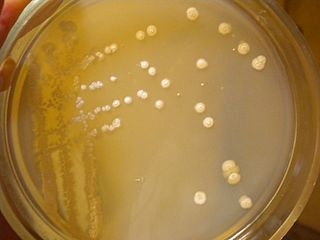
Streptomyces is the largest genus of Actinomycetota and the type genus of the family Streptomycetaceae. Over 500 species of Streptomyces bacteria have been described. As with the other Actinomycetota, streptomycetes are gram-positive, and have genomes with high GC content. Found predominantly in soil and decaying vegetation, most streptomycetes produce spores, and are noted for their distinct "earthy" odor that results from production of a volatile metabolite, geosmin.
Streptomyces spectabilis is a bacterium species from the genus of Streptomyces. Streptomyces spectabilis produces hangtaimycin, gentamicin, kanamycin, neomycin B, sisomycin, tobramycin, paromomycin, spectinabilin, spectinomycin, aminocyclitol, actinospectacin, prodigiosine and the streptovaricin complex.
Streptomyces candidus is a bacterium species from the genus of Streptomyces which has been isolated from soil in Russia. Streptomyces candidus produces lemonomycin, enterocin, pyrazofurin and avoparcin.
Streptomyces coeruleorubidus is a bacterium species from the genus of Streptomyces which has been isolated from marine sediment. Streptomyces coeruleorubidus produces the following medications: pacidamycin 1, baumycin B1, baumycin B2, baumycin C1, feudomycin A, feudomycin B, feudomycin C, ficellomycin, feudomycinone A, and rubomycin.
Streptomyces diastatochromogenes is a bacterium species from the genus of Streptomyces. Streptomyces diastatochromogenes produces polyketomycin, concanamycin A, concanamycin B, concanamycin C, momofulvenone A, azdimycin, toyocamycin and oligomycins.

Streptomyces gardneri is a bacterium species from the genus of Streptomyces. Streptomyces gardneri produces thiopeptide A, proactinomycin A, proactinomycin B, proactinomycin C.
Streptomyces griseoaurantiacus is a thermotolerant bacterium species from the genus of Streptomyces which was isolated from marine sediment. Streptomyces griseoaurantiacus produces the antibiotics manumycin, diperamycin and chinikomycin, and griseolic acid.
Streptomyces griseoflavus is a bacterium species from the genus of Streptomyces which has been isolated from garden soil. Streptomyces griseoflavus produces bicozamycin, colabomycins A, colabomycins C, germacradienol and hormaomycin.
Streptomyces griseorubens is a bacterium species from the genus of Streptomyces which has been isolated from soil. Streptomyces griseorubens produces althiomycin. Streptomyces griseorubens produces matamycin and althiomycin.
Streptomyces griseorubiginosus is a bacterium species from the genus of Streptomyces which has been isolated from soil in Russia. Streptomyces griseorubiginosus produces arylsulfatase, biphenomycin A, cinerubin A and cinerubin B.
Streptomyces griseoviridis is a filamentous bacterium species from the genus Streptomyces, which was isolated from soil in Texas, United States. Streptomyces griseoviridis produces etamycin, griseoviridin, bactobolin, prodigiosin R1, actinobolin, and rosophilin. Streptomyces griseoviridis can be used to protect plants since it inhibits the growth of fungal pathogens.
Streptomyces longisporoflavus is a bacterium species from the genus of Streptomyces which has been isolated from soil. Streptomyces longisporoflavus produces tetronasin and staurosporine.
Streptomyces nitrosporeus is a bacterium species from the genus of Streptomyces which has been isolated from garden soil in Japan. Streptomyces nitrosporeus produces Benzastatin E, Benzastatin F, Benzastatin G Nitrosporeusine A and Nitrosporeusine B and the antibiotics nitrosporin and virantomycin and the inhibitor of angiotensin-converting enzyme foroxymithine. Streptomyces nitrosporeus can degrade cellulose.
Streptomyces niveus is a bacterium species from the genus of Streptomyces which has been isolated from soil in the United States. Streptomyces niveus produces the aminocoumarin antibiotic novobiocin and the compounds nivetetracyclate A and nivetetracyclate B.

Streptomyces olivaceus is a bacterium species from the genus of Streptomyces which has been isolated from soil. Streptomyces olivaceus produces granaticin, elloramycin, tetroazolemycin A and tetroazolemycin B. Streptomyces olivaceus can be used to produce vitamin B12.
Streptomyces rishiriensis is a bacterium species from the genus of Streptomyces which has been isolated from soil in Hokkaido in Japan. Streptomyces rishiriensis produces coumermycin A1, notomycin, 2-chloroadenosine, phosphophenylalanarginine and lactonamycin.
Streptomyces sanglieri is a bacterium species from the genus of Streptomyces which has been isolated from soil from a hay meadow. Streptomyces sanglieri produces the antibiotic lactonamycin Z.
Streptomyces showdoensis is a bacterium species from the genus of Streptomyces which has been isolated from soil in Shōdoshima, Japan. Streptomyces showdoensis produces terferol, actinomycin and showdomycin.
Streptomyces tateyamensis is a bacterium species from the genus of Streptomyces which has been isolated from the sponge Haliclona from the pacific coastline of the city Tateyama in the Chiba prefecture in Japan. Streptomyces tateyamensis produces the antibiotic thiopeptin B.
Streptomyces virginiae is a bacterium species from the genus of Streptomyces which has been isolated from soil. Streptomyces virginiae produces actithiazic acid, virginiamycins and cycloserine. Streptomyces virginiae also produces monensin A, monensin B, monensin C, monensin D, actithiazic acid.



